
Psilocybe tampanensis is a very rare psychedelic mushroom in the family Hymenogastraceae. Originally collected in the wild in a sandy meadow near Tampa, Florida, in 1977, the fungus would not be found in Florida again until 44 years later. The original Florida specimen was cloned, and descendants remain in wide circulation. The fruit bodies (mushrooms) produced by the fungus are yellowish-brown in color with convex to conic caps up to 2.4 cm (0.9 in) in diameter atop a thin stem up to 6 cm (2.4 in) long. Psilocybe tampanensis forms psychoactive truffle-like sclerotia that are known and sold under the nickname "philosopher's stones". The fruit bodies and sclerotia are consumed by some for recreational or entheogenic purposes. In nature, sclerotia are produced by the fungus as a rare form of protection from wildfires and other natural disasters.

Psilocybe MP caerulipes, commonly known as blue-foot, is a rare psilocybin mushroom of the family Hymenogastraceae, having psilocybin and psilocin as main active compounds. An older synonym is Agaricus caerulipes.
Gymnopilus communis is a species of agaric fungus in the family Strophariaceae. Found in Veracruz, Mexico, it was described as new to science in 1994.

Architrypethelium is a genus of lichen-forming fungi in the family Trypetheliaceae. The genus was circumscribed in 1991 by Dutch lichenologist André Aptroot, with A. seminudum assigned as the type species. It is a segregate of genus Trypethelium.

Psilocybe aztecorum is a species of psilocybin mushroom in the family Hymenogastraceae. Known from Arizona, Colorado, central Mexico, India and Costa Rica, the fungus grows on decomposing woody debris and is found in mountainous areas at elevations of 2,000 to 4,000 m, typically in meadows or open, grassy conifer forests. The mushrooms have convex to bell-shaped caps 1.5–2 cm (0.6–0.8 in) in diameter, atop slender cylindrical stems that are up to 7.5 cm (3.0 in) long. The color of the caps changes with variations in hydration, ranging from dark chestnut brown to straw yellow or whitish when dry. The base of the stem is densely covered with conspicuous white rhizomorphs, a characteristic uncommon amongst Psilocybe species.

Psilocybe hispanica is a species of fungus in the family Hymenogastraceae. It produces small brown mushrooms with conical to convex caps up to 10 mm (0.4 in) in diameter and stems 16 to 25 mm long by 0.5 to 1 mm thick. Reported as new to science in 2000, it is only known from the Pyrenees mountain range in northern Spain and southwestern France, where it grows on horse dung in grass fields at elevations of 1,700 to 2,300 m. The mushroom contains the psychoactive compound psilocybin. The possible depiction of this species in the 6,000-year-old Selva Pascuala rock art suggests that it might have been used in ancient religious rituals—the oldest evidence of such usage in prehistoric Europe.

Psilocybe yungensis is a species of psychedelic mushroom in the family Hymenogastraceae. In North America, it is found in northeast, central and southeastern Mexico. In South America, it has been recorded from Bolivia, Colombia, and Ecuador. It is also known from the Caribbean island Martinique, and China. The mushroom grows in clusters or groups on rotting wood. The fruit bodies have conical to bell-shaped reddish- to orangish-brown caps that are up to 2.5 cm (1.0 in) in diameter, set atop slender stems 3 to 5 cm long. The mushrooms stain blue when bruised, indicative of the presence of the compound psilocybin. Psilocybe yungensis is used by Mazatec Indians in the Mexican State of Oaxaca for entheogenic purposes.

Punctelia hypoleucites, commonly known as the southwestern speckled shield lichen, is a species of foliose (leafy) lichen in the family Parmeliaceae. First formally described by Finnish botanist William Nylander as a species of Parmelia, it was transferred to the genus Punctelia in 1982. The lichen is found in Africa, North America, and South America, where it grows on the bark of both hardwood and coniferous trees. Its greenish-grey thallus is covered with tiny white pseudocyphellae – minute holes in the thallus surface that facilitate gas exchange. Some macroscopic features that help distinguish this species from other related members of the genus include the presence and the structure of the apothecia, the absence of asexual surface propagules, and the light brown color of the thallus undersurface. Chemically, the presence of lecanoric acid in the medulla and atranorin in the cortex help distinguish it from lookalikes.
Chiodecton lichexanthonicum is a species of crustose and corticolous (bark-dwelling) lichen in the family Roccellaceae. Found in the Brazilian Amazon, it was formally described as a new species in 2017 by lichenologists Marcela Eugenia da Silva Cáceres and André Aptroot. The type was collected by the authors from the Adolfo Ducke Forest Reserve, along trails near a field station; here, in old-growth rainforest, it was found growing on tree bark. The specific epithet lichexanthonicum refers to its major cortical compound, lichexanthone. It is the first species in genus Chiodecton known to contain this compound. Chiodecton lichexanthonicum has narrow, club-shaped ascospores with seven septa that measure 30–34 by 2.5–3.5 μm.
Enterographa lichexanthonica is a species of crustose and corticolous (bark-dwelling) lichen in the family Roccellaceae. Found in the Brazilian Amazon, it was formally introduced as a new species in 2017 by lichenologists Marcela Eugenia Cáceres and André Aptroot. The type specimen was collected by the authors from the Adolfo Ducke Forest Reserve, along trails near a field station; here, it was found growing on tree bark in a old-growth rainforest. The lichen has a thin, dull, pale greenish thallus surrounded by a thin black prothallus. Its ascospores are hyaline, have seven septa, and measure 21–27 by 5–6 μm; they have a 1 μm-thick gelatinous sheath surrounding them. The specific epithet lichexanthonica refers to lichexanthone, a secondary chemical that occurs in the cortex of the lichen. This compound causes the lichen to fluoresce yellow when a UV light is shone upon it. Enterographa lichexanthonica is morphologically similar to E. kalbii, but this latter species has lichexanthone only on the ascomata, not on the thallus.
Cryptothecia lichexanthonica is a species of corticolous (bark-dwelling) lichen in the family Arthoniaceae. Found in Brazil, it was formally described as a new species in 2013 by Edvaneide Leandro de Lima, André Aptroot, and Marcela Eugenia da Silva Cáceres. The type specimen was collected by Lima from the Vale do Catimbau National Park, at an altitude of 885 m (2,904 ft); here it was found growing on smooth tree bark. The lichen has a smooth, pale greenish-grey spreading thallus up to 5 cm (2 in) in diameter. The thallus, which is 0.1–0.2 mm thick, is surrounded by a thin brown hypothallus. The ascospores are muriform, ellipsoid in shape, and measure 55–75 by 22–28 μm. The specific epithet lichexanthonica refers to lichexanthone, a secondary chemical that occurs in the thallus. This compound is rare in the genus Cryptothecia, as the only other congener in which it known is to occur is Cryptothecia assimilis.
Marcelaria benguelensis is a tropical species of corticolous (bark-dwelling) and crustose lichen in the family Trypetheliaceae. It is found in continental southeast Asia.
Ocellularia upretii is a species of corticolous (bark-dwelling) lichen in the family Graphidaceae. It is found in India.
Lecanactis rubra is a species of corticolous (bark-dwelling), crustose lichen in the family Roccellaceae. Found in Madagascar, it was formally described as a new species in 2009 by Damien Ertz and Emmanuël Sérusiaux. The type specimen was collected by Sérusiaux from the gorge of Manambolo at an altitude of 300 m (980 ft). At this location, about 3 km (1.9 mi) upstream from Bekopaka, in a dry forest with calcareous soil, it was found growing on bark. This lichen is only known to occur at the type locality.
Ocellularia pluriporoides is a species of corticolous (bark-dwelling) lichen in the family Graphidaceae. Found in Northern Thailand, it was formally described as a new species in 2002 by lichenologists Natsurang Homchantara and Brian J. Coppins. The type specimen was collected in Doi Suthep National Park at an elevation of 1,600 m (5,200 ft); here, in an oak/chestnut forest, it was found growing on the trunk of Vaccinium sprengelii.
Acanthothecis submuriformis is a species of corticolous (bark-dwelling) lichen in the family Graphidaceae. Found in Brazil, it was formally described as a new species in 2022 by André Aptroot, Robert Lücking, and Marcela Eugenia da Silva M.Cáceres. The type specimen was collected from the Parque Natural Municipal ; here the lichen was found growing on tree bark in primary rainforest.
Carbacanthographis subchionophora is a species of corticolous (bark-dwelling) lichen in the family Graphidaceae. Found in Papua New Guinea and Brazil, it was formally described as a new species in 2022 by Shirley Cunha Feuerstein and Robert Lücking. The type specimen was collected from Kagi Village. It is similar to Carbacanthographis chionophora, but unlike that lichen, it does not contain lichexanthone. The specific epithet subchionophora refers to its resemblance with this species.
Astrothelium macroeustomum is a species of corticolous (bark-dwelling) lichen in the family Trypetheliaceae. Found in French Guiana, it was formally described as a new species in 2019 by lichenologists André Aptroot and Harrie Sipman. The type specimen was collected by Sipman from the Piste Crique Limonade at an altitude of 300 m (980 ft). The lichen has a mostly smooth, pale ochraceous-brown thallus that is somewhat shiny and covers areas up to 9 cm (4 in) in diameter. It is surrounded by a dark brown prothallus. It has pear-shaped (pyriform) ascomata, measuring 0.6–1.0 mm in diameter, which mostly aggregate in groups of two to five, and are more or less immersed in the tissue of the bark, below the thallus surface. They have convex, black ostioles (pores) that are surrounded by a yellowish-white ring of pruina. The ascospores are hyaline, spindle-shaped (fusiform) with five septa and measure 50–55 by 12–17 μm. The lichen contains lichexanthone, a lichen product that causes the ostioles of the ascomata to fluoresce yellow when lit with a long-wavelength UV light. The specific epithet macroeustomum refers to both its large spores and its similarity to Astrothelium eustomum.
Astrothelium stromatofluorescens is a species of corticolous (bark-dwelling) lichen in the family Trypetheliaceae. It is only known to occur in a few locations in Brazil and Bolivia.
Architrypethelium penuriixanthum is a species of corticolous (bark-dwelling) lichen in the family Trypetheliaceae. Found in Bolivia, it was formally described as a new species in 2016 by lichenologists Adam Flakus and André Aptroot. The type specimen was collected near Sehuencas village, Carrasco Province ; there, at an elevation of 2,220 m (7,280 ft) it was found in a mountainous Yungas cloud forest. It is similar to Architrypethelium hyalinum, but unlike that species, does not have lichexanthone in its thallus. The species epithet penuriixanthum alludes to the absence of xanthones.






